US Offshore Wind: Tax Machines Offset Bad Economics
By Allen Brooks -- February 28, 2017“While the ITC option eliminates the uncertainty of performance, it is also consistent with the view of Warren Buffett, considered one of the outstanding investors of all-time. He has said, ‘[O]n wind energy, we get a tax credit if we build a lot of wind farms. That’s the only reason to build them. They don’t make sense without the tax credit.’”
“Responding to his critics about the economics of Deepwater Wind, CEO Jeffrey Grybowski said: ‘We’re building clean energy for the next generation here. And I think there are always small-minded opponents who like to find conspiracies.’ But I doubt most Rhode Islanders consider themselves either ‘small-minded’ or conspiracy-theorists.”
America’s renewable energy industry recently opened a new chapter with the official startup of the Block Island Wind Farm located 3.8 miles off the coast of Block Island in Rhode Island state waters.
The wind farm was developed and is owned by Deepwater Wind LLC, which is an arm of the D. E Shaw Group, a global investment and technology firm with $38 billion of invested capital as of July 1, 2016. After receiving approval from Rhode Island’s Coastal Resources Management Council (CRMC) to begin operations, the 30-megawatt, five-turbine project was switched on December 5th.
Background
This historical event followed nearly 18 months of construction and testing, becoming the first offshore wind farm to operate in the United States. The timeline for the project was much longer than anticipated, having started its regulatory journey in April 2008 when Rhode Island issued a request for proposals to construct an offshore wind farm in furtherance of the state’s efforts to promote renewable energy resources.
In 2004, Rhode Island’s legislature established a goal of meeting 15% of the state’s electrical needs from renewable resources by 2020. That effort was furthered by an executive order in 2006 of then-Governor Donald L. Carcieri (Rep.) that established a goal that 15% of “Rhode Island’s electricity demand will be supplied by environmentally progressive wind power.”
In recognition of the strong wind patterns offshore the United States, as mapped by the National Oceanic and Atmospheric Agency (NOAA), Rhode Island enlisted professors from the University of Rhode Island to undertake an assessment of the wind resources in state waters, which led to the creation of the Ocean Special Area Management Plan (Ocean SAMP) in 2008 under the supervision of the state’s CRMC. One of the areas identified by the Ocean SAMP was offshore Block Island, the site of the Deepwater Wind project.
Exhibit 1. Block Island Is In A Strong Ocean Wind Area Source: Old Harbor
The Ocean SAMP provided a road map for the development and facilitated an expedited approval process by a friendly government agency. CRMC had oversight of the permitting process and construction. It also possessed the authority to hire independent consultants to review the hardware manufacturing and wind turbine construction. CRMC was also involved in permitting the construction of an offshore electrical cable connecting Block Island to the mainland linking the previously isolated island from receiving electricity from the state’s power grid rather than having to generate it all on the island.
This isolation had contributed to very high power prices – in the neighborhood of $0.50 per kilowatt-hour (kWh) – from generators powered by diesel fuel. Diesel accounted for about half the cost of the power. The cable provides bi-directional movement of electricity so that any excess wind power can flow to the mainland, while when the wind isn’t blowing, the grid can supply power to homes and businesses on the island. A slight problem the state had with the underwater power cable was that the residents of Narragansett didn’t want it landing in their town. In response to the town’s rejection, the state elected to have it cross a part of the state’s Scarborough beach, which just happens to be located in Narragansett.
Exhibit 2. GE Wind Turbine Generator Source: GE
Exhibit 3. How The GE Wind Turbine Creates Electricity Source: GE
The wind farm did experience a slight hitch with the start-up process as one of the turbines (number two) was damaged during the testing phase. After inspection, it appears that either the installer or the manufacturer left behind a 6-inch drill bit, which was found lodged in a gap between the generator and the direct-drive system. The picture in Exhibit 2 (previous page) shows a generator and the direct-drive unit without the blades. Exhibit 3 (previous page) shows a schematic of how the generator and direct-drive unit works.
The damaged magnets in the generator will be replaced under the warranty from General Electric (GE-NYSE), the builder of the Haliade unit. Each magnet weighs about 60 pounds and they will be lifted manually up the 330-foot tall tower to the generator housing where they will replace the damaged ones. It is interesting that the unit’s warranty lasts for only 15 years, while the projected life of the unit for financial analysis purposes is estimated at 20 years.
Most of the wind turbines in operation are projected to become less efficient in their later lives, and that is why many of them are replaced after 15 years of service. Exhibits 4 and 5 (next page) put the generator unit’s location and size in perspective with the overall wind turbine’s scope.
Exhibit 4. How A GE Wind Turbine Is Structured Source: GE
The key ingredient for the success of the project was the state’s support for Deepwater Wind’s expensive power-purchase agreement (PPA) with Rhode Island’s primary electricity provider, National Grid (NGG-NYSE). The initial agreement was rejected by the Rhode Island Public Utilities Commission (PUC) as uneconomic, a decision that was reversed following the state’s legislature approving a new law restricting the ability of the PUC to consider a
Exhibit 5. An Example Of A Block Island Wind Turbine Source: GE
cost/benefit analysis of the PPA and requiring it to approve the PPA if it merely found any economic benefit from a clean power project constructed in the state. The subsequent approval of the PPA led to legal challenges by industrial power consumers over the cost of electricity, which was spread among all recipients of power regardless of whether they provided their own power, which National Grid merely delivered.
There was a simple reason why the state legislature didn’t want the PUC to conduct any further cost/benefit analyses since the economics of offshore wind are not very attractive. A recent analysis of levelized costs of various power generating sources shows how expensive offshore wind is compared to nuclear, coal and natural gas power sources.
Levelized economic analysis assumes that all kilowatt-hours of power generated are equal in value, regardless of when during a day the power is produced. This report, prepared by investment firm Lazard Ltd. (LAZ-NYSE), shows that the unsubsidized levelized cost of power from onshore wind turbines ranges between $32 and $77 per megawatt-hour (MWh). The median prices targeted for offshore wind is $152/MWh. These cost estimates do not include any costs for social and environmental externalities such as vibration, flicker, humming or the killing of bats and protected eagles.
One of the arguments made for the progress renewables are having in reducing their costs is reflected in Exhibit 6 (next page). It shows how much the unsubsidized levelized cost of wind and solar power have declined over the six-year period, 2009-2015. In the case of wind, we would note that the primary cost improvement phase occurred in 2009 and 2010, and since then the pace of cost improvement has been slower. Over the six-year period, the
Exhibit 6. How Electricity Generating Fuels Compare Source: Lazard
average wind cost declined 61%, but since 2011, it has only declined by 33%, and between 2014 and 2015, the decline was 7.4%. In other words, the pace of decline in wind power costs have slowed over time raising questions about whether the cost decreases will continue in the future, and at what rate.
Exhibit 7. How The Cost Of Wind And Solar Have Fallen Source: Lazard
With the start-up of the Block Island Wind Farm, Deepwater Wind can now begin collecting 24.4 cents/kWh for the electricity the turbines produce. That rate will increase by 3.5% annually for the 20-year life of the PPA. This means that in 2036 consumers will be paying 47.9 cents/kWh. Currently, residential customers are paying 8.179 cents/kWh for their electricity, or one-third the price of Block Island power. At the time the PPA was negotiated, the ratio between the proposed Block Island power price and what Rhode Island electricity customers were paying was only about a two-to-one ratio, rather than today’s three-to-one ratio.
Equally as important for Deepwater Wind is that it can now begin collecting on the federal tax incentives for renewable fuel production. There are two options: 1) receive a tax credit of $0.023/kWh of power generated, or 2) accept an immediate 30% credit of the cost to construct the wind farm. We have read that Deepwater Wind is planning on taking the second option, which based on a quick analysis would seem to be financially the best choice.
There seems to be some confusion as to exactly how much the Block Island Wind Farm cost to build. The number $300 million is frequently reported as the cost, which is close to the estimated $290 million in long-term financing Deepwater Wind secured in order to construct the project. In another place we have seen an estimate that the equipment, construction and installation totaled $225 million, with $118 million for design, legal and permitting, plus $108 million for the undersea cable.
While Deepwater Wind was initially going to have to construct the cable, it eventually reached an agreement with National Grid for them to assume that cost. What we do not know is how much, if any, of the $108 million figure represents the cost of the cable to connect the five turbines together and bring the power initially to shore, and how much represents the cost to take the cable from Block Island to the mainland. If we assume that the entire $108 is the cost to National Grid, then the other two expenses total $343 million rather than $300 million. In either case, if all these costs are eligible for the 30% investment tax credit (ITC), then Deepwater Wind is eligible for an immediate tax credit of an estimated $90 million to $102.9 million.
When we examine the benefits from the production tax credit for producing wind power, we must make some assumptions about the amount of power that will be generated. The math goes like this: a 1-Megawatt (MW) generator produces 1,000 kilowatts of power per hour (kWh), if it is producing continuously.
There are 8,760 hours in a year, so that 1-MW generator produces 8,760,000/kWh a year. Since the turbines are rated for 6 MWs, then a single Block Island Wind Farm turbine generates 52,560,000/kWh a year if operating full time. The Block Island Wind Farm, having five turbines, would produce 262,800,000/kWh a year. We have seen an estimate that the wind farm will be selling 125,000,000/kWh of electricity per year, which implies a 47.6% efficiency rate.
While that efficiency is above the top-end of estimates for offshore wind turbine performance, given that these turbines represent new technology, we will accept the higher performance estimate. With that efficiency and the $0.244/kWh price for the power, the wind farm will generate $30.5 million a year in revenue. At $0.023/kWh, it will create $2.875 million a year in production tax credits (PTC). Those figures are for the first year as the PPA provides for a guaranteed 3.5% annual escalation in the price of electricity generated.
For analytical simplicity, we assumed the wind farm’s output remains constant over the first 10 years of operation, which is the period during which it is eligible for the PTC. Under our assumptions, Deepwater Wind would generate $357.8 million in revenue and $28.75 million in PTCs, over the 10 years. Deepwater Wind has the option to collect either PTCs or take an immediate 30% ITC against other profits.
As Deepwater Wind is a subsidiary of the D.E. Shaw Group, we believe the wind farm ITC has an immediate tax-shelter benefit for its owner. The projected PTC credits that would be earned under our assumptions represent less than one-third of the immediate ITC amount. Another advantage of selecting the ITC over the PTC is that it eliminates the risk that the power generated by the turbines falls below the 48% efficiency ratio, cutting down on eligible power credits.
While the ITC option eliminates the uncertainty of performance, it is also consistent with the view of Warren Buffett, considered one of the outstanding investors of all-time. He has said, “[O]n wind energy, we get a tax credit if we build a lot of wind farms. That’s the only reason to build them. They don’t make sense without the tax credit.”
His view was supported by a study commissioned by the wind industry in 2015 showing that with the current subsidies, wind will produce eight gigawatts of power nationally, but without them, we will only have two gigawatts of power. More to the implications of the renewable subsidies is an analysis of the PTC, which has been in place since 1992, or for 24 years. In 2014, the PTC cost Americans $12 billion in tax subsidies, as wind power generation grew, versus an average cost over the period of about $5 billion a year. Today, wind accounts for about 5% of total electricity production in this country.
For electricity customers in Rhode Island, the Block Island Wind Farm PPA is estimated to add between $1.07 and $1.35 per month to their power bills. Estimates presented to the Rhode Island PUC in 2015 show that local customers will pay an above-market price of $440 million for Deepwater Wind’s output over the life of the PPA. That estimate has grown to more than $500 million due to escalated costs for the wind farm and its underwater power cable.
When challenged by critics about the economics of Deepwater Wind, CEO Jeffrey Grybowski was quoted saying, “I think they miss what we’re really trying to do here, which is to build a new clean energy industry in Rhode Island, something that’s gained tremendous international attention. We’re building clean energy for the next generation here. And I think there are always small-minded opponents who like to find conspiracies.”
I doubt most Rhode Islanders consider themselves either “small-minded” or conspiracy-theorists. Moreover, I don’t believe they considered themselves leaders of a revolution creating a new industry. I think they were merely for what Deepwater Wind initially promised: cheap, competitive electricity.
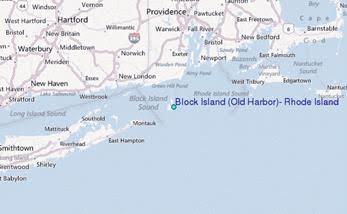
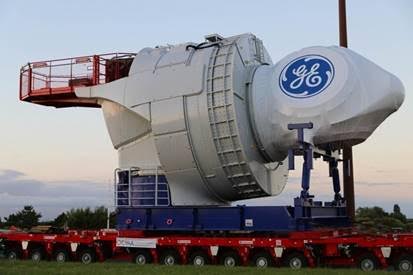
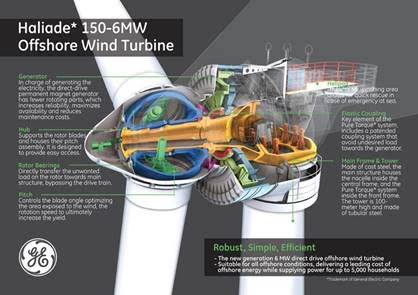
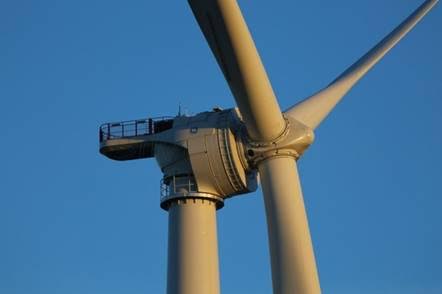
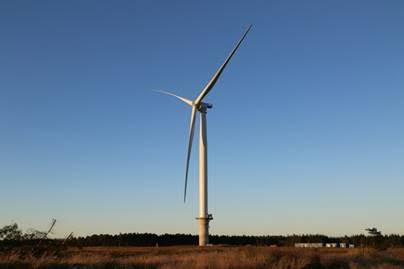
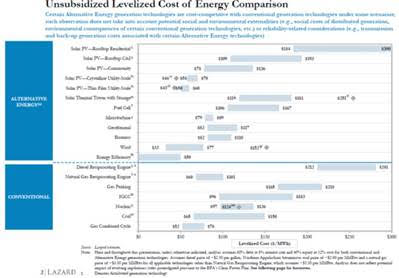
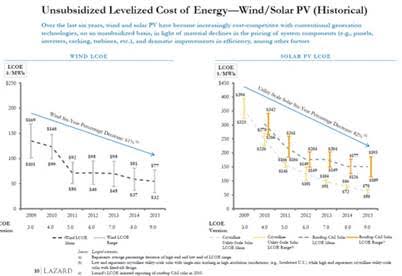
With big enough wings (subsidies), even pigs can be made to fly. Look at this offshore wind energy folly, right here in New England.
The Block Island Wind Farm, after many years of dithering, became operational in late 2016. It is located 3.8 miles east of Block Island, Rhode Island. It has five wind turbines, each with a capacity of 6 megawatt. Each turbine is about 589 feet tall.
The annual wind energy production would be about 105,000 megawatt-hour, at a capacity factor of 0.40. The estimated useful service life is about 25 years. Turnkey project cost is about $290 million, or $9.67 million/MW, which is outrageously high.
Quick Estimate of Energy Cost: If the major costs of 25-year financing, a return on investment, operation and maintenance, and replacements were ignored, the cost of energy production, just to return the capital, would be about $290 million/(20 y x 105,000 MWh/y) = 13.8 cents per kilowatt-hour.
If these costs were not ignored, the cost of energy would be at least 20 cents. That would be about the price charged to utilities under a long-term power purchase agreement, PPA. This energy would be variable and intermittent, i.e., no wind, no energy.
Other generators, likely gas-fired, would be required to provide supplementary energy on a year-round basis, i.e., do the peaking, filling-in and balancing, which degrades their efficient operation. This efficiency degradation increases as more wind energy is added to the grid.
http://www.windtaskforce.org/profiles/blogs/fuel-and-co2-reductions…
See the rest of the text of this article using this URL
http://www.windtaskforce.org/profiles/blogs/a-very-expensive-offshore-wind-energy-folly-in-new-england